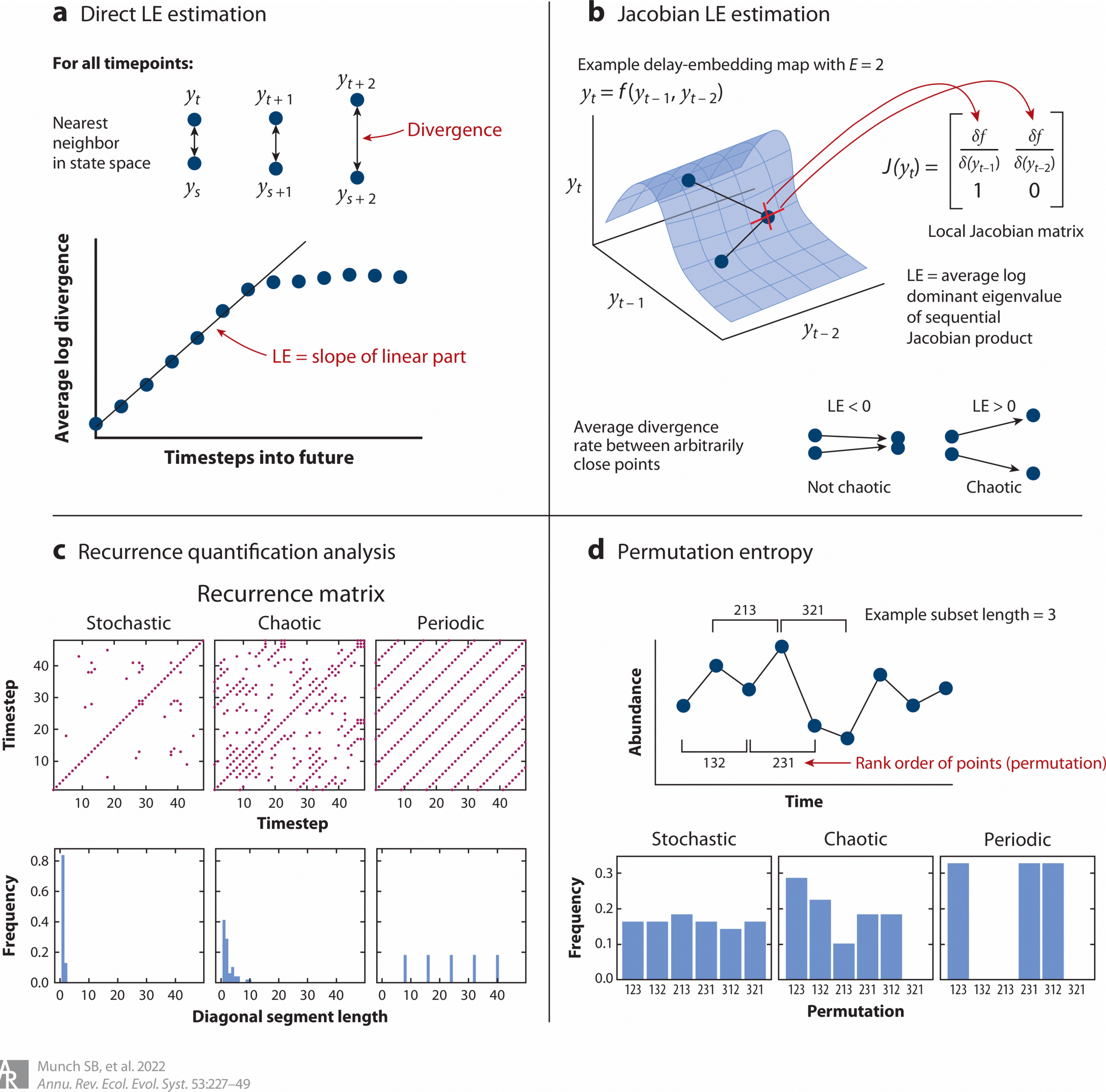Assistant Professor
Prof. Cheng-Han Tsai
Prof. Cheng-Han Tsai

中文
TEL:+886-6-275-7575 ext.58138
Email: tsaich@gs.ncku.edu.tw
Research interests:
community ecology、marine ecological resource management、coral reef ecosystem、nonlinear dynamics、decision process
TEL:+886-6-275-7575 ext.58138
Email: tsaich@gs.ncku.edu.tw
Research interests:
community ecology、marine ecological resource management、coral reef ecosystem、nonlinear dynamics、decision process
Research highlights:
- Biodiversity change and ecosystem stability: We explore how increasing coral cover volatility, driven by climate change and human activities, affects the structure and stability of reef fish assemblages. Using a spatially replicated dataset from the Great Barrier Reef, it highlights the shifting balance between deterministic niche-based processes, such as species traits, and stochastic fluctuations, which become dominant under volatile conditions. While species diversity, measured by richness and evenness, remains stable, erosion of niche structure poses risks to the provision of ecosystem functioning and services. These findings challenge traditional biodiversity metrics that overlook structural changes driven by environmental variability. By partitioning variance in relative species abundance, our study underscores the need for dynamic approaches that capture temporal and structural shifts of biodiversity. Our study advocates for adaptive conservation strategies, emphasizing that preserving diversity alone is insufficient to maintain ecosystem stability. See Tsai & Connolly 2025, Tsai et al. 2022.

- Nonlinear forecasting and ecosystem-based management: Our study bridges theoretical advances and practical applications in ecological forecasting and fisheries science, focusing on the challenges of managing short-lived marine species. Traditional stock assessment models often fail to capture the nonlinear dynamics of these species, resulting in outdated or inaccurate benchmarks. To address this, our study applies Empirical Dynamic Modeling (EDM), a nonlinear, equation-free approach, to establish robust management reference points, such as maximum sustainable yield (MSY), by considering unobserved ecosystem interactions and environmental drivers. We use penaeid shrimp stock dynamics as a proof of concept, showcasing EDM’s ability to predict nonlinear dynamics and spatial synchrony, improving real-time fisheries management and enabling adaptive policies. These findings demonstrate the potential of EDM to transform the management of short-lived, dynamic species from reactive to proactive, offering a robust framework for sustainable resource management. See Tsai et al. 2024, Tsai et al. 2023.

- Chaos in ecology and evolution: We review the long-held assumption that chaos is rare in natural ecosystems. By synthesizing advancements in methods such as recurrence quantification, permutation entropy, and algorithms based on Takens theorem, we argue that natural systems frequently harbor conditions for chaotic dynamics. These insights challenge traditional equilibrium-based models and highlight the limitations of past approaches due to data constraints and reliance on low-dimensional frameworks. See Munch et al. 2022.

Education
| Ph.D. Degree | Australian Institute of Marine Science, James Cook University, Australia |
| Master Degree | Department of Forestry and Resource Conservation, National Taiwan University, Taiwan |
| Bachelor’s Degree | Department of Forestry and Resource Conservation, National Taiwan University, Taiwan |
Experience
| 2024–Present | Assistant Professor, Department of Life Sciences, National Cheng Kung University, Taiwan |
| 2022–2024 | Postdoctoral Researcher, Department of Applied Mathematics, University of California Santa Cruz, USA |
| 2021–2022 | Postdoctoral Researcher, Department of Ecology and Evolutionary Biology, University of California Santa Cruz, USA |
| 2021–2024 | Postdoctoral Researcher, NOAA Southwest Fisheries Science Center, USA |
| 2011–2014 | Research Assistant, Institute of Oceanography, National Taiwan University, Taiwan |
| 2010–2011 | Research Assistant, Institute of Oceanography, National Taiwan University, Taiwan |
Awards and Honors
Publications
- Tsai C. H., Connolly S. (2025). Environmental gradients linked to human impacts, not species richness, drive regional variation in community stability in coral reef fishes. Ecology Letters, 28(4), e70001.
- Miki T., Chang C. W., Ke P. J., Telschow A., Tsai C. H., Ushio M., Hsieh C. H. (2025). How to quantify interaction strengths? A critical rethinking of the interaction Jacobian and evaluation methods for non-parametric inference in time series analysis. Physica D: Nonlinear Phenomena, 476, 134613.
- Tsai C. H., Munch S., Masi M., Stevens, M. (2024). Empirical dynamic modelling for sustainable benchmarks of short-lived species. ICES Journal of Marine Science, 81(7), 1209–1220.
- Tsai C. H., Munch S., Masi M., Pollack A. (2023). Predicting nonlinear dynamics of short-lived penaeid shrimp species in the Gulf of Mexico. Canadian Journal of Fisheries and Aquatic Sciences, 80(1), 57–68.
- Munch S., Rogers T., Johnson B., Bhat U., Tsai C. H. (2022). Rethinking the prevalence and relevance of chaos in ecology. Annual Review of Ecology, Evolution, and Systematics, 53, 227–249.
- Tsai C. H., Sweatman H., Thibaut L., Connolly S. (2022). Volatility in coral cover erodes niche structure, but not diversity, in reef fish assemblages. Science Advances, 8(24), eabm6858.
- Kuo C. Y., Tsai C. H., Huang Y. Y., Heng W. K., Hsiao A. T., Hsieh H. J., Chen C. A. (2022). Fine intervals are required when using point intercept transects to assess coral reef status. Frontiers in Marine Science, 9, 795512.
- Nakazawa T., Liu S. Y. V., Sakai Y., Araki K. S., Tsai C. H., Okuda N. (2018). Spatial genetic structure and body size divergence in endangered Gymnogobius isaza in ancient Lake Biwa. Mitochondrial DNA Part A, 29(5), 756–764.
- Tsai C. H., Hsieh C. H., Nakazawa T. (2016). Predator–prey mass ratio revisited: does preference of relative prey body size depend on predator body size? Functional Ecology, 30, 1979–1987.
- Chang-Yang C. H., Sun I. F., Tsai C. H., Lu C. L., Hsieh C. F. (2016). ENSO and frost co-determine decade-long temporal variation in flower and seed production in a subtropical rainforest. Journal of Ecology, 104, 44–54.
- Tsai C. H., Lin Y. C., Wiegand T., Su S. H., Nakazawa T., Hsieh C. H., Ding T. S. (2015). Individual species–area relationship of woody plant communities in a heterogeneous subtropical monsoon rainforest. PLOS ONE, 10, e0124539.
- Tsai C. H., Miki T., Chang C. W., Ishikawa K., Ichise S., Kumagai M., Hsieh C. H. (2014). Phytoplankton functional group dynamics explain species abundance distribution in a directionally changing environment. Ecology, 95, 3335–3343.
- Briones J. C., Tsai C. H., Nakazawa T., Sakai Y., Papa R. D., Hsieh C. H., Okuda N. (2012). Long-term changes in the diet of Gymnogobius isaza from Lake Biwa, Japan: effects of body size and prey availability. PLOS ONE, 7, e53167.
- Nakazawa T., Tsai C. H., Ishida N., Kato M. (2011). Annual variations in length–weight relationships of Gymnogobius isaza from Lake Biwa, Japan. Journal of Applied Ichthyology, 27, 1135–1136.









